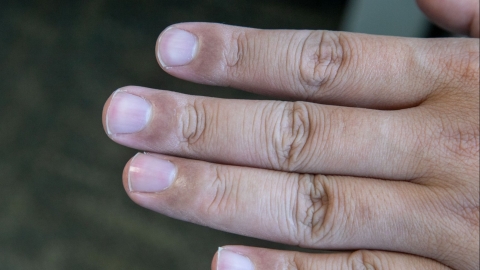How to treat nail indentation
Generally, nail pitting may be caused by malnutrition, long-term exposure to chemicals, nail damage from psoriasis, eczema, Raynaud's disease, and other conditions. It can usually be treated through nutritional supplementation, avoiding harmful substances, and medication. If abnormalities occur, prompt medical consultation is recommended. Detailed analysis is as follows:

1. Malnutrition: Long-term deficiency of nutrients such as calcium, iron, and vitamins can affect normal nail growth, leading to structural abnormalities and nail pitting. It is recommended to adjust the diet, increase consumption of calcium-rich foods such as milk and soy products, iron-rich foods like animal liver and lean meat, and vitamin-rich fresh fruits and vegetables. Nutritional supplements may also be taken when necessary.
2. Long-term exposure to chemicals: Frequent contact with chemicals such as detergents, disinfectants, and paint can irritate the nails, damaging their normal structure and causing pitting. Exposure to such chemicals should be minimized, and gloves should be worn for protection when contact is necessary. Regular nail care, such as applying hand cream to keep the skin around the nails moisturized, is also recommended.
3. Psoriatic nail involvement: When psoriasis affects the nails, it can cause small, pinpoint depressions resembling those on a thimble. This is often accompanied by skin symptoms such as redness and scaling. Treatment primarily involves the use of medications such as calcipotriol ointment, tacrolimus ointment, and acitretin capsules as directed by a physician.
4. Eczema: Recurrent eczema with inflammation involving the skin around the nails and the nail matrix can affect nail growth, leading to nail pitting. Symptoms often include itching, redness, and discharge around the skin of the nails. Treatment with medications such as desonide cream, loratadine syrup, and mometasone furoate cream should be conducted under medical guidance.
5. Raynaud's disease: After exposure to cold or emotional stress, small arteries in the fingers spasm and constrict, causing circulatory disturbances in the nails and impairing nutrient supply, which can lead to nail pitting. This is often accompanied by color changes in the fingers, such as pallor, cyanosis, and redness, along with numbness and pain. Treatment should follow medical advice and may include medications such as nifedipine tablets, reserpine tablets, and niacin tablets.
In daily life, maintaining good habits, ensuring a balanced diet, avoiding nail injuries and exposure to chemicals, and keeping hands warm are important for maintaining nail health. If nail pitting continues to worsen or is accompanied by other discomforts, timely medical consultation is advised.







